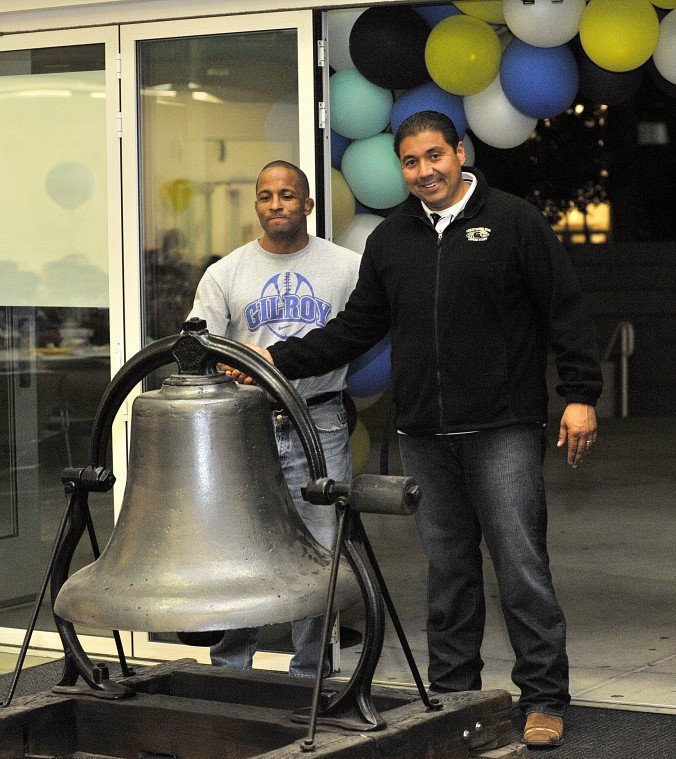
Activities Director Gloria Hennessy at Christopher High School says she “can’t stand by and do nothing” when she sees one of her students coming to school wearing clothing that is worn out or shoes that are about to fall apart.
Her situation is no anomaly. She’s one of many Gilroy Unified School District teachers that help students financially in and out of the classroom, regularly spending hundreds out-of-pocket to purchase classroom supplies, lunches and even toothbrushes.
It’s a national trend, as public school teachers in the United States spent more than $1.33 million of their own money on school supplies and instructional materials in the 2009-2010 school year, according to a report by the National School Supply and Equipment Association.
GUSD administrative staff and principals are no different, regularly footing the bill to pay for students’ academic as well as personal needs.
That includes Christopher High School Principal John Perales, who admitted that he and many other teachers quietly cover all sorts of expenses for students, never expecting to be reimbursed.
“Many times I have run out to Target and charged something for a student, and I know our teachers do it all the time. Of course, they do not have to, but they care, you know?” Perales said.
While GUSD does have some money to spend on each classroom for essentials such as paper, pencils and teaching materials, times are tight as the district was forced to reduce its operating costs by $20 million over the past four years due to massive state budget cuts.
“We had to eliminate so many line items,” Superintendent Debbie Flores explained. “We still have money for classroom supplies in the budget, but unfortunately, not as much as we used to.”
Leanne Gaxiola, secretary to Principal Marco Sanchez at Gilroy High School, comes from a family of teachers and knows that a teacher paying for students’ needs is “not a new thing.”
“My mother was a teacher for 39 years and my sister is a teacher at Christopher High School. You could call any teacher here at GHS – take your pick, A to Z – and you would likely hear the same story of spending their own money on classroom and personal items for their students,” she said.
State Superintendent Tom Torlakson of Public Instruction expresses respect for generous teachers, but hopes one day the cost will not fall to them.
“It’s no secret that teachers use their own money to buy what schools cannot provide, and the deep cuts to school budgets of recent years have only made matters worse,” he told the Dispatch. “As much as I applaud the generosity of teachers, I think we all long for the day when every school has what it needs to provide children the world-class education they deserve, without relying on teachers to reach into their wallets.”
It’s a plaguing issue that Superintendent Flores has many years of personal experience with.
“My husband is a teacher and I was a teacher for many years,” she said. “We just did our taxes and my husband paid in the $2,500 to $3,000 range last year for classroom materials and other supplies for his students.”
The Internal Revenue Service allows teachers to take a mere $250 deduction per year for unreimbursed expenses when paying for books, supplies and other materials used in the classroom. According to the Internal Revenue Code, an individual can “claim this deduction if he or she is a kindergarten through grade 12 teacher, instructor, counselor, principal, or aide, that works at least 900 hours a school year in a school that provides elementary or secondary education, as determined under state law.”
Flores gave several examples of particularly generous GUSD teachers and staff who have shelled out their own money for a myriad of student needs, but added that she was reluctant to name individuals because there are “way, way too many to list.”
“Holiday donation drives, teachers buying clothing and dinners for families,” Flores said, listing off examples. “One year, the teachers at South Valley Middle School raised $1,800 to take 14 families to Target so they could buy what they needed. Afterward, they took them all to dinner.”
CHS Athletic Director Darren Yafai has experienced situations where a student could not pay a fee to participate in athletics.
“Many times a student will come to a coach and say they want to participate in a sport, but their families cannot afford the jersey, or other fee, and we will waive that fee and use money from the site ASB fund,” he said.
The ASB fund consists of money from fundraisers, but that’s a small amount, according to Yafai, so “fundraisers and parent support are key.”
Yafai admitted that he, as well as many other teachers he knows, personally cover the cost for classroom and teaching supplies “all the time.” He added that in years past, the district could afford to allot site budgets for programs – but now, “we rely heavily on boosters and other fundraising. Without it, athletic programs just could not exist.”
Each circumstance is on a case-by-case basis, Hennessy added. But it all adds up.
“You see a need as a teacher, and it’s $30, and you figure, ‘okay, I can do that,’” she said. “But if a teacher ever started keeping track of how much they spent this way they would probably freak out … or their spouse would freak out. I don’t think a day goes by when a teacher isn’t helping this way.”
Hennessy also described a recent instance in which teachers got together to purchase certain items needed by a student in order to go on a school trip. This included personal items such as a toothbrush and toothpaste.
“I wouldn’t want to ever know that I could have done something for a student, but didn’t know about it,” she added.
According to a National School Supply and Equipment Association, which released a “2010 Retail Market Awareness Study” based on a survey of 308 kindergarten through 12th-grade teachers, results showed that teachers spent on average $356 of their own money on supplies and materials. Of that, $170 went to supplies and $186 to instructional materials. The survey did not include any miscellaneous personal items bought by teachers for students.
“Teachers personally spending on average $1,500 to $2,000 per year is commonplace,” Flores said. “I know some teachers who spend $3,000 to $4,000 per year of their own money on teaching materials and classroom resources.”
CHS Attendance Secretary Julie Graham said her job can be the “first line of defense” for students who need help.
“Often we notice first when there’s a problem or a student is going south because they don’t show up for school for a few days, or begin to be regularly tardy,” Graham said. “When I see a student that looks troubled I ask them how it’s going and if they’ve had breakfast that morning. They say they are fine, but then I discover they haven’t had breakfast.”
Because of this, Graham said she keeps a stash of fruit and water in the office for students who need it.
It’s not just about breakfast, she added, but also “building trust with the students, so they know they can come back to (CHS staff) when they need help with any problem in their lives, such as drugs, trouble at home, even pregnancy … anything.”
The California Department of Education reports that the average certified teacher salary in Santa Clara County for the 2011-2012 school year was $63,338. In Gilroy, is was $57,180.
“I know teachers send leftover food from class parties home with students, and some teachers even pay for Internet service in students’ homes so they can do their homework,” Graham said. “One of the biggest things I hope parents will know is that the teachers and the administrative staff truly care about the children’s well-being, and I hope parents take a moment to thank a teacher for all they do.”













